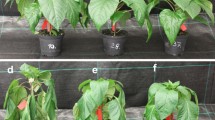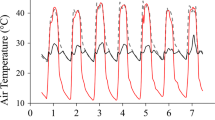Abstract
The effect of exposure of sweet cherry trees (Prunus avium L.) to non-freezing low temperature was investigated by measurements of chlorophyll fluorescence, gas exchange parameters and chlorophyll content in two experiments. In Experiment I, cultivars ‘Grace Star’ and ‘Schneiders’ were exposed to an average of 4.7 °C 21 and 27 days after full blooming (DAFB) and in Experiment II, cultivar ‘Grace Star’ to 2.2 °C 50 DAFB, for one, two or three consecutive nights. The aim of the present study was to evaluate the effect of low temperature exposure (LTE) on leaf physiology, recovery time and differences between cultivars in response to chilling stress. After the first, second and third LTE, a decrease in maximum and effective quantum yield of PS II (Fv/Fm and Fv′/Fm′), net photosynthesis (Pn), stomatal conductance (gs) and transpiration (E) was observed. Multiple LTE caused a greater physiological disturbance than single LTE. The recovery time after multiple LTE was prolonged. Trees with one and two LTE reached similar values to the controls within 24 and 48 h, respectively, while trees with three LTE did not reach within 48 h. The LTE in Experiment I showed no effect on Fv/Fm, while two LTE induced lower Pn, gs and E. After LTE, no differences between cultivars were found. The effect of chilling stress was more pronounced at lower temperatures and when the trees were chilled for several consecutive nights.





Similar content being viewed by others
Abbreviations
- PS II:
-
Photosystem II
- Fv/Fm :
-
Maximum quantum yield of photosystem II
- Fv′/Fm′:
-
Effective quantum yield of photosystem II
- Pn:
-
Net photosynthesis
- gs:
-
Stomatal conductance
- E:
-
Transpiration
- Ci:
-
Intercellular leaf CO2 concentration
- CSR:
-
Cold storage room
- DAFB:
-
Days after full blooming
- GDD:
-
Growing degree days
- NPQ:
-
Nonphotochemical quenching
- Td:
-
Average daily temperature
- Tn:
-
Average night temperature
- Tmin:
-
Minimum night temperature
- SE:
-
Standard error
- LTE:
-
Low temperature exposure
- LT:
-
Low temperature
- LT1:
-
One exposure to low temperature
- LT2:
-
Two consecutive exposures to low temperature
- LT3:
-
Three consecutive exposures to low temperature
- .-24:
-
Measurements before starting an experiment I (at time -24)
- LT1.0:
-
Measurements immediately after one low temperature exposure
- LT2.0:
-
Measurements immediately after two consecutive low temperature exposures
- LT3.0:
-
Measurements immediately after three consecutive low temperature exposures
- LT1.24:
-
Measurements 24 h after one low temperature exposure
- LT2.24:
-
Measurements 24 h after two consecutive low temperature exposures
- LT3.24:
-
Measurements 24 h after three consecutive low temperature exposures
- LT1.48:
-
Measurements 48 h after one low temperature exposure
- LT2.48:
-
Measurements 48 h after two consecutive low temperature exposures
- LT3.48:
-
Measurements 48 h after three consecutive low temperature exposures
- C.-24:
-
Control measurements before starting an experiment I (at time -24)
- C.0:
-
Control measurements at time 0
- C.24:
-
Control measurements at time 24
- C.48:
-
Control measurements at time 48
- C.72:
-
Control measurements at time 72
- C.96:
-
Control measurements at time 96
References
Allen DJ, Ort DR (2001) Impacts of chilling temperatures on photosynthesis in warm-climate plants. Trends Plant Sci 6:36–42. https://doi.org/10.1016/S1360-1385(00)01808-2
Allen DJ, Ratner K, Giller YE, Gussakovsky EE, Shahak Y, Ort DR (2000) An overnight chill induces a delayed inhibition of photosynthesis at midday in mango (Mangifera indica L.). J Exp Bot 51:1893–1902. https://doi.org/10.1093/jexbot/51.352.1893
ARSO, Slovenian Environment Agency (2020) http://www.arso.gov.si/en/. Accessed 1 Mar 2020
Bertamini M, Muthuchelian K, Rubinigg M, Zorer R, Nedunchezhian N (2005) Low-night temperature (LNT) induced changes of photosynthesis in grapevine (Vitis vinifera L.) plants. Plant Physiol Biochem 43:693–699. https://doi.org/10.1016/j.plaphy.2005.06.001
Bertamini M, Muthuchelian K, Rubinigg M, Zorer R, Velasco R, Nedunchezhian N (2006) Low-night temperature increased the photoinhibition of photosynthesis in grapevine (Vitis vinifera L. cv. Riesling) leaves. Environ Exp Bot 57:25–31. https://doi.org/10.1016/j.envexpbot.2005.04.002
Bilska-Kos A, Panek P, Szulc-Głaz A, Ochodzki P, Cisło A, Zebrowski J (2018) Chilling-induced physiological, anatomical and biochemical responses in the leaves of Miscanthus × giganteus and maize (Zea mays L.). J Plant Physiol 228:178–188. https://doi.org/10.1016/j.jplph.2018.05.012
Ensminger I, Busch F, Huner NP (2006) Photostasis and cold acclimation: sensing low temperature through photosynthesis. Physiol Plant 126:28–44. https://doi.org/10.1111/j.1399-3054.2006.00627.x
Flexas J, Badger M, Chow WS, Medrano H, Osmond CB (1999) Analysis of the relative increase in photosynthetic O2 uptake when photosynthesis in grapevine leaves is inhibited following low night temperatures and/or water stress. Plant Physiol 121:675–684. https://doi.org/10.1104/pp.121.2.675
Foyer CH, Vanacker H, Gomez LD, Harbinson J (2002) Regulation of photosynthesis and antioxidant metabolism in maize leaves at optimal and chilling temperatures. Plant Physiol Biochem 40:659–668. https://doi.org/10.1016/S0981-9428(02)01425-0
Gill SS, Tuteja N (2010) Reactive oxygen species and antioxidant machinery in abiotic stress tolerance in crop plants. Plant Physiol Biochem 48:909–930. https://doi.org/10.1016/j.plaphy.2010.08.016
Hou W, Sun A, Chen H, Yang F, Pan J, Guan M (2016) Effects of chilling and high temperatures on photosynthesis and chlorophyll fluorescence in leaves of watermelon seedlings. Biol Plant 60:148–154. https://doi.org/10.1007/s10535-015-0575-1
Hu W, Song X, Shi K, Xia X, Zhou Y, Yu J (2008) Changes in electron transport, superoxide dismutase and ascorbate peroxidase isoenzymes in chloroplasts and mitochondria of cucumber leaves as influenced by chilling. Photosynthetica 46:581. https://doi.org/10.1007/s11099-008-0098-5
Ibrahim MM, Bafeel SO (2008) Photosynthetic efficiency and pigment contents in alfalfa (Medicago sativa) seedlings subjected to dark and chilling conditions. Int J Agric Biol 10:306–310
Ikkonen E, Shibaeva T, Sysoeva M, Sherudilo E (2012) Stomatal conductance in Cucumis sativus upon short-term and long-term exposures to low temperatures. Russ J Plant Physiol 59:696–699. https://doi.org/10.1134/S102144371205007X
IPCC (2018) Global warming of 1.5 °C. An IPCC special report on the impacts of global warming of 1.5 °C above pre-industrial levels and related global greenhouse gas emission pathways, in the context of strengthening the global response to the threat of climate change, sustainable development, and efforts to eradicate poverty. In: Masson-Delmotte et al. (eds) Summary for Policy Makers. IPCC, Geneva. https://www.ipcc.ch/site/assets/uploads/sites/2/2018/07/SR15_SPM_version_stand_alone_LR.pdf. Accessed 5 Mar 2020
Jan N, Andrabi KI (2009) Cold resistance in plants: a mystery unresolved. Electron J Biotechnol 12:14–15
Kalisz A, Jezdinský A, Pokluda R, Sękara A, Grabowska A, Gil J (2016) Impacts of chilling on photosynthesis and chlorophyll pigment content in juvenile basil cultivars. Hortic Environ Biotechnol 57:330–339. https://doi.org/10.1007/s13580-016-0095-8
Lambers H, Chapin FS, Pons TL (2008) Plant physiological ecology. Springer, New York
Lee JH, Oh MM (2015) Short-term low temperature increases phenolic antioxidant levels in kale. Hortic Environ Biotechnol 56:588–596. https://doi.org/10.1007/s13580-015-0056-7
Leng P, Qi J (2003) Effect of anthocyanin on David peach (Prunus davidiana Franch) under low temperature stress. Sci Hortic 97:27–39. https://doi.org/10.1016/S0304-4238(01)00374-0
Liu Y, Qi M, Li T (2012) Photosynthesis, photoinhibition, and antioxidant system in tomato leaves stressed by low night temperature and their subsequent recovery. Plant Sci 196:8–17. https://doi.org/10.1016/j.plantsci.2012.07.005
Liu X, Xu N, Wu Y, Zhong H, Zhang H (2019) Photosynthesis, chilling acclimation and the response of antioxidant enzymes to chilling stress in mulberry seedlings. J For Res 30:2021–2029. https://doi.org/10.1007/s11676-018-0811-6
Maxwell K, Johnson GN (2000) Chlorophyll fluorescence—a practical guide. J Exp Bot 51:659–668. https://doi.org/10.1093/jexbot/51.345.659
McMaster GS, Wilhelm W (1997) Growing degree-days: one equation, two interpretations. Agric For Meteorol 87:291–300
Measham PF, Quentin AG, MacNair N (2014) Climate, winter chill, and decision-making in sweet cherry production. Hortic Sci 49:254–259. https://doi.org/10.21273/HORTSCI.49.3.254
Pearce RS (1999) Molecular analysis of acclimation to cold. Plant Growth Regul 29:47–76. https://doi.org/10.1023/A:1006291330661
Ploschuk E, Bado L, Salinas M, Wassner D, Windauer L, Insausti P (2014) Photosynthesis and fluorescence responses of Jatropha curcas to chilling and freezing stress during early vegetative stages. Environ Exp Bot 102:18–26. https://doi.org/10.1016/j.envexpbot.2014.02.005
Ruelland E (2017) Plant responses to chilling temperatures. In: Shabala S (ed) Plant stress physiology, 2nd edn. CABI, Wallingford, pp 97–137
Ruelland E, Vaultier MN, Zachowski A, Hurry V (2009) Cold signalling and cold acclimation in plants. Adv Bot Res 49:35–150. https://doi.org/10.1016/S0065-2296(08)00602-2
Sawicki M, Aït Barka E, Clément C, Vaillant-Gaveau N, Jacquard C (2015) Cross-talk between environmental stresses and plant metabolism during reproductive organ abscission. J Exp Bot 66:1707–1719. https://doi.org/10.1093/jxb/eru533
Shibaeva T, Ikkonen E, Sherudilo E, Titov A (2019) Effects of a daily short-term temperature drop on chilling-sensitive and cold-resistant plants. Russ J Plant Physiol 66:530–539. https://doi.org/10.1134/S1021443719040125
Taiz L, Zeiger E (2002) Plant physiology, 3rd edn. Sinauer Associates, England
R Core Team (2019) R: A language and environment for statistical computing. R Foundation for Statistical Computing, Vienna. https://www.R-project.org. Accessed 5 Mar 2020
Turan Ö, Ekmekci Y (2014) Chilling tolerance of Cicer arietinum lines evaluated by photosystem II and antioxidant activities. Turk J Bot 38:499–510. https://doi.org/10.3906/bot-1309-7
Veselova S, Farkhutdinov R, Veselov D, Kudoyarova G (2006) Role of cytokinins in the regulation of stomatal conductance of wheat seedlings under conditions of rapidly changing local temperature. Russ J Plant Physiol 53:756. https://doi.org/10.1134/S1021443706060057
Zhang S, Scheller HV (2004) Photoinhibition of photosystem I at chilling temperature and subsequent recovery in Arabidopsis thaliana. Plant Cell Physiol 45:1595–1602. https://doi.org/10.1093/pcp/pch180
Zhang L, Ferguson L, Whiting MD (2018) Temperature effects on pistil viability and fruit set in sweet cherry. Sci Hortic 241:8–17. https://doi.org/10.1016/j.scienta.2018.06.039
Acknowledgements
This work was supported by the Slovenian Research Agency (ARRS), Young Researchers Program (MV) and research core funding nos. P4-0013 (MV, MH, VU) and P4-0085 (DK, DV).
Author information
Authors and Affiliations
Contributions
All authors conceived and designed the work. MV, MH, DV and VU participated in data collection. DK and MV performed the statistical analyses; MV wrote manuscript, VU, DV and DK edited and critically revised the manuscript. All authors read and approved the final version of the paper.
Corresponding author
Ethics declarations
Conflict of interest
There’s no financial/personal interest or belief that could affect the objectivity of the study.
Additional information
Communicated by Heakeun Yun, Ph.D.
Publisher's Note
Springer Nature remains neutral with regard to jurisdictional claims in published maps and institutional affiliations.
Electronic supplementary material
Below is the link to the electronic supplementary material.
Rights and permissions
About this article
Cite this article
Vosnjak, M., Kastelec, D., Vodnik, D. et al. The physiological response of the sweet cherry leaf to non-freezing low temperatures. Hortic. Environ. Biotechnol. 62, 199–211 (2021). https://doi.org/10.1007/s13580-020-00315-w
Received:
Revised:
Accepted:
Published:
Issue Date:
DOI: https://doi.org/10.1007/s13580-020-00315-w




